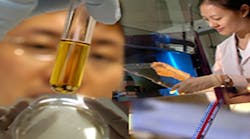While the physical location of Singapore, at the heart of the continually expanding Asian economy, goes a long way toward explaining its manufacturing success, the pivotal factor is the country's strategic plan that matches needs with resources.
With a population of only 5.4 million, manpower is limited. The challenge is to align the available human capital with economic sectors poised for growth in the region. One sector that fits this requirement, and in which the country has already found success, is biomedical sciences.
In fact the country's vision, according to the Singapore Economic Development Board, is to become the "Biopolis of Asia." Under A*STAR (Agency for Science, Technology and Research), there are 7,100 researchers carrying out biomedical science R&D for 50 companies, universities and 30 public-sector institutes.
"We understand the need of companies, who are interested in locating or expanding here in Singapore, to be able to quickly draw upon the expertise of workers in the field of biologics," explains Kevin Lai, director of Biomedical Sciences and Consumer Businesses, at the Singapore Economic Development Board. "We have been told that the quality of our talent has really stood out."
Creating a pipeline of quality talent was not an accident. "Since 2000 we have turned out 1,000 PhDs and post doctorate scholars at a cost of almost S$1million each," says Lai.
Programs to ensure that education is indeed matching future company needs include the Board's Medical Technology IDEAS (Innovate, Design, Engineer for Asia in Singapore) which enables multidisciplinary teams of engineers, VOC specialists and regulatory experts to experience on-the-job training. And the Singapore-Stanford Biodesign Programme which teams the Board, A*STAR's and Stanford University to meet the region's need for Asian medical device innovators familiar with Asia's unique clinical and market needs.
Currently the medical technology manufacturing sector employs more than 9,000 skilled workers and will grow to more than 20,000 science and engineering graduates entering the workforce from Singapore's tertiary institutions each year.
There are also more than 300,000 skilled employees in related sectors (e.g. pharmaceutical, electronics, engineering).
Major Players Seeking Foothold in Region
The availability of current talent coupled with a strong future pipeline has not gone unnoticed. Eight of the top 10 pharmaceutical companies have regional headquarters in Singapore. And that number is expanding. Just last month AbbVie Inc., which is a research-based biopharmaceutical company, formed in 2013 following separation from Abbott, opened its first manufacturing plant in Singapore.
"As Asia's fastest-growing bio-cluster, Singapore is an ideal location to expand our manufacturing network while maintaining rigorous standards of quality and delivery for the patients we serve around the world," said Azita Saleki-Gerhardt, Ph.D., senior vice president, Operations, AbbVie.
Last year heavyweight manufacturer, Amgen, announced plans to build a new manufacturing facility in the Tuas Biomedical Park area.
Also last year Thermo Fisher Scientific expanded its cell culture and bioprocessing capabilities which created the first-ever cell culture dry powder media production site in Singapore.
facility is the first-ever cell culture dry powder media production site in Singapore.
"In the first phase of development in this sector, trust is a very important ingredient," explains Lai. "Our system closely mirrors both the U.S. and the UK. IP laws are strong, international trade practices are standard and the culture of doing business is very similar."
The groundwork for attracting these important global companies was created fourteen years ago with the creation of A*STAR. As the ultimate goal was to commercialize research, the group was placed under the Ministry of Industry. And funding of research, innovation and enterprise activities is budgeted at S$16.1 billion from 2011 until 2015. Of this $3.7 billion is targeted to enhance biomedical R&D research infrastructure, integrating multi-disciplinary research and "translating basic science into tangible outcomes" according to the Board.
To further expand the Biomedical sector, two years ago BMS Industry Partnership Office (IPO) was set up. It's a multi-agency office that includes the National Medical Research Council Ministry of Health, A*STAR and the Board. It is a one-stop shop for companies in the sector to engage multiple Singapore agencies in research collaborations.
"We realize that over the past five to ten years R&D has changed. As a result forming partnerships is very important. Our organization can facilitate public-private partnerships in this sector based on research and other development needs," Lai explains.
Another important foundation of the strategic plan is the physical locations, such as Medtech Hub and Tuas Biomedical Park, that can offer contract manufacturing services, reverse logistics services and sterilization services as well as integrated logistics services.
These value-added services will be necessary with the growth expected in the area. "Asia continues to be our fastest-growing market and a central contributor to our growth," said Greg Herrema, president of Biosciences at Thermo Fisher Scientific.
Bayer Healthcare also sees the growth potential and last year joined with five research institutes in Singapore to create a new Integrated Translational Oncology Network.
"Singapore is uniquely positioned as a research hub for Bayer HealthCare, " said Thomas Steffen, country division head of Bayer HealthCare Pharmaceuticals for Singapore, Malaysia and Brunei. " We have access to the key ethnic groups in Asia, which affords us greater clinical insights to the disease biology of Asian prevalent cancers, and a growing pool of translational and clinical research talents with access to the necessary research facilities and scientific infrastructure."
Access to this population is important to all medical-related companies since the region's population is expected to dramatically increase between now and 2050. This population will grow 314% from 207 million to 857 million.
Singapore is ready. It is employing the same tactics it always has, aligning resources with opportunities. "We hold quarterly meetings with an advisory council to talk about issues that cut across industry sectors," says Lai. "We explore what types of training will be necessary to meet future demand. We review supply chain and infrastructure concerns. And we create strategies to make sure we remain not only competitive but are on the forefront of this sector in the region. "




